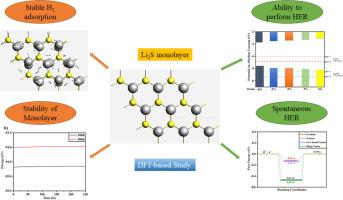Strain-modulated photocatalytic hydrogen production and storage capacity analysis of Li2S monolayer: A DFT approach
IF 6.3
2区 材料科学
Q2 CHEMISTRY, PHYSICAL
引用次数: 0
Abstract
The theoretical prospect of Li2S monolayer for hydrogen production and storage is reported. The density functional theory is used to examine its structural, electronic, photocatalytic, optical properties, and hydrogen storage capabilities under biaxial strain. The phonon dispersion graphs alongside AIMD simulations at 300 K & 500 K confirmed the structure as stable. The investigated material revealed itself as a direct band gap semi-conductor and good optical absorption in the visible region under all applied strains. The suitable band edge positions and spontaneous water splitting for hydrogen evaluation reaction under 4% biaxial strain make it a leading candidate for hydrogen production. Furthermore, the hydrogen storage analysis revealed that the highest adsorption energy for H2 adsorption appears when monolayer is under -4% strains. For full storage analysis, studied monolayer adsorbed 21 H2 with an average adsorption energy () of -0.276 eV and desorption temperature of 352.9 K at -4% strain. Its gravimetric capacity is evaluated as 9.3% which swiftly surpasses the landmark of 5.5% from US department of energy and many renowned materials like C3N (6.78%), and C3N4 (7.29%). Therefore, Li2S monolayer under biaxial strain can be estimated as an ideal candidate for hydrogen’s production and storage.

应变调制光催化制氢及Li2S单层储氢容量分析:DFT方法
报道了Li2S单层制氢和储氢的理论前景。利用密度泛函理论研究了其结构、电子、光催化、光学性质以及在双轴应变下的储氢能力。声子色散图和AIMD模拟在300k和500k下证实了该结构是稳定的。所研究的材料在所有施加的应变下都是直接带隙半导体,在可见光区具有良好的光吸收。在4%双轴应变条件下,该带边位置适宜,且能自发地劈裂水,是产氢的主要候选带。此外,储氢分析表明,在-4%菌株下,单层膜对H2的吸附能最高。对于全存储分析,研究了在-4%应变下,单分子膜吸附2h2的平均吸附能(Ead)为-0.276 eV,解吸温度为352.9 K。其重量容量评估为9.3%,迅速超过了美国能源部5.5%的里程碑,以及许多著名的材料,如C3N(6.78%)和C3N4(7.29%)。因此,双轴应变下的Li2S单层可以被认为是一种理想的产氢和储氢材料。
本文章由计算机程序翻译,如有差异,请以英文原文为准。
求助全文
约1分钟内获得全文
求助全文
来源期刊

Surfaces and Interfaces
Chemistry-General Chemistry
CiteScore
8.50
自引率
6.50%
发文量
753
审稿时长
35 days
期刊介绍:
The aim of the journal is to provide a respectful outlet for ''sound science'' papers in all research areas on surfaces and interfaces. We define sound science papers as papers that describe new and well-executed research, but that do not necessarily provide brand new insights or are merely a description of research results.
Surfaces and Interfaces publishes research papers in all fields of surface science which may not always find the right home on first submission to our Elsevier sister journals (Applied Surface, Surface and Coatings Technology, Thin Solid Films)
 求助内容:
求助内容: 应助结果提醒方式:
应助结果提醒方式:


